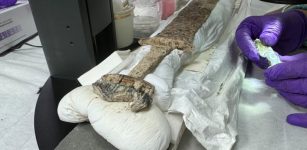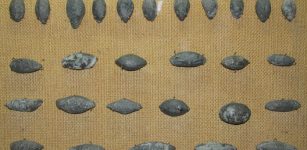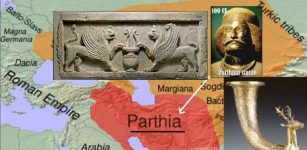What Happened To The Staircase In The Temple Of The Goddess Hathor?
Ellen Lloyd - AncientPages.com - Dedicated to one of the most famous deities of ancient Egypt, the magnificent temple of Goddess Hathor is the largest and most impressive building in the Denderah temple complex.
It is one of the best-preserved temples in all of Egypt, and it has been modified several times starting as far back as the Middle Kingdom (between 2030 and 1650 B.C.).

Hathor's head. Faience, from a sistrum's handle. 18th Dynasty. From Thebes, Egypt. The Petrie Museum of Egyptian Archaeology, London. Image credit: Wikipedia
Goddess Hathor Was One Of The Most Popular Goddesses In Ancient Egypt
Hathor was a goddess who personified the principles of joy, feminine love, and motherhood. She was known as “the Great One of Many Names,” and her titles and attributes are so numerous that she was influential in every area of life and death for the ancient Egyptians.
She was a sky goddess, known as the “Lady of Stars” and “Sovereign of Stars,” and linked to Sirius (and so the goddesses Sopdet and Isis). Her birthday was celebrated when Sirius first rose in the sky. By the Ptolemaic period, she was known as the goddess of Hethara, the third month of the Egyptian calendar.
Goddess Hathor was also associated with Sistrum, a magical and sacred ancient Egyptian musical instrument.
Inside the Temple of Hathor is a large and small Hypostyle Hall, laboratory, storage magazine offering entry, several shrines, and many ancient depictions of Cleopatra VI, an Egyptian Ptolemaic queen.
Damage To The Western Staircase Inside The Temple Of Hathor
Two staircases, one on the west and one on the east, lead to the roof terrace from the first antechamber.
During the New Year's festival, the ba of Hathor would emerge from the crypt beneath the temple and be carried up the western staircase to the roof to a kiosk in the southwest corner. There, she would await the first light of the dawn of the New Year and symbolically merge with the Sun.
Credit: Konstantin - Adobe Stock
Once the goddess had merged with the Sun she was carried back down the staircase on the eastern side of the temple before returning to the crypt. The priests would ascend by the western staircase and descend by the east staircase.
The western staircase leading to the roof of the Temple of the Goddess Hathor is decorated with beautiful images of the pharaoh, his priests, and the goddess.
The staircase is in bad condition, and it almost looks like someone dropped a bucket of cement down the steps. What caused the damage to the stairs? Could the explanation be that the stairs have been exposed to natural elements like water and air for thousands of years? Are the stairs simply worn because of old age?
Can tourists be blamed, or did something else happen inside the Temple of Hathor?
Written by Ellen Lloyd – AncientPages.com
Copyright © AncientPages.com All rights reserved. This material may not be published, broadcast, rewritten or redistributed in whole or part without the express written permission of AncientPages.com
Expand for referencesMore From Ancient Pages
-
 Prehistoric Humans Recycled Old Stone Tools To Preserve The Memory Of Their Ancestors
Archaeology | Mar 17, 2022
Prehistoric Humans Recycled Old Stone Tools To Preserve The Memory Of Their Ancestors
Archaeology | Mar 17, 2022 -
 Wonderful Ancient Mosaics In Ancient City Of Zeugma, Turkey
Archaeology | Dec 12, 2015
Wonderful Ancient Mosaics In Ancient City Of Zeugma, Turkey
Archaeology | Dec 12, 2015 -
 King Solomon’s Copper Mines In The Timna Valley Did Not Pollute Environment – Geochemical Surveys Reveal
Archaeology | Dec 23, 2024
King Solomon’s Copper Mines In The Timna Valley Did Not Pollute Environment – Geochemical Surveys Reveal
Archaeology | Dec 23, 2024 -
 Ancient Coffin Of Priest Psamtik, Son Of Osiris And Five Replicas Of Goddess Maat Sent On Upcoming Expo
Archaeology | Oct 5, 2021
Ancient Coffin Of Priest Psamtik, Son Of Osiris And Five Replicas Of Goddess Maat Sent On Upcoming Expo
Archaeology | Oct 5, 2021 -
 10,000 Years Ago Cattle Was Domesticated In The Central Nile Region – New Study
Archaeology | May 23, 2022
10,000 Years Ago Cattle Was Domesticated In The Central Nile Region – New Study
Archaeology | May 23, 2022 -
 Spectacular 6th Century Sword With Runes Found In Anglo-Saxon Grave Near Canterbury In Kent
Archaeology | Dec 27, 2024
Spectacular 6th Century Sword With Runes Found In Anglo-Saxon Grave Near Canterbury In Kent
Archaeology | Dec 27, 2024 -
 Crannogs – Artificial Islands In Scotland Are Older Than Stonehenge
Archaeology | Jun 17, 2019
Crannogs – Artificial Islands In Scotland Are Older Than Stonehenge
Archaeology | Jun 17, 2019 -
 Mysterious Stone Spheres Could Be From Ancient Greek Board Game – Scientists Say
Archaeology | Sep 30, 2022
Mysterious Stone Spheres Could Be From Ancient Greek Board Game – Scientists Say
Archaeology | Sep 30, 2022 -
 On This Day In History: Battle Of Lugdunum Was Fought – On Feb 19, 197
News | Feb 19, 2017
On This Day In History: Battle Of Lugdunum Was Fought – On Feb 19, 197
News | Feb 19, 2017 -
 Beer ‘Chicha’ Helped To Keep Peruvian Wari Empire Stable – New Study
Archaeology | Apr 23, 2019
Beer ‘Chicha’ Helped To Keep Peruvian Wari Empire Stable – New Study
Archaeology | Apr 23, 2019 -
 A 2000-Year-Old Jewish Settlement Near Bet Shemesh – Unearthed
Archaeology | Mar 30, 2017
A 2000-Year-Old Jewish Settlement Near Bet Shemesh – Unearthed
Archaeology | Mar 30, 2017 -
 Next Discovery In Tepe Ashraf, Isfahan – Archaeologists May Have Stumbled Upon Ancient Necropolis
Archaeology | Aug 16, 2020
Next Discovery In Tepe Ashraf, Isfahan – Archaeologists May Have Stumbled Upon Ancient Necropolis
Archaeology | Aug 16, 2020 -
 Composition Of A 2,000-Year-Old Roman Perfume Identified For The First Time
Archaeology | May 26, 2023
Composition Of A 2,000-Year-Old Roman Perfume Identified For The First Time
Archaeology | May 26, 2023 -
 Scientists Solve The Mystery Of Cicero’s Puzzling Words By Analyzing Ancient Roman Coins – Evidence Of Financial Crisis?
Artifacts | Apr 6, 2022
Scientists Solve The Mystery Of Cicero’s Puzzling Words By Analyzing Ancient Roman Coins – Evidence Of Financial Crisis?
Artifacts | Apr 6, 2022 -
 Mystery Of The Delphi Oracle Prophecies: Was Pythia On Drugs While Guiding Ancient Greek Civilization For Thousands Of Years?
Civilizations | Nov 3, 2016
Mystery Of The Delphi Oracle Prophecies: Was Pythia On Drugs While Guiding Ancient Greek Civilization For Thousands Of Years?
Civilizations | Nov 3, 2016 -
 Spectacular Vardzia Cave Monastery – Huge Underground Complex Founded By The ‘Mountain Queen’ Tamar
Featured Stories | Dec 28, 2015
Spectacular Vardzia Cave Monastery – Huge Underground Complex Founded By The ‘Mountain Queen’ Tamar
Featured Stories | Dec 28, 2015 -
 Shrine Discovered In Egyptian Temple And Evidence Of Previously Unknown Rituals
Archaeology | Oct 6, 2022
Shrine Discovered In Egyptian Temple And Evidence Of Previously Unknown Rituals
Archaeology | Oct 6, 2022 -
 Queen Dido Of Carthage: Founder Of Prosperous City On Africa’s Northern Coast
Featured Stories | May 21, 2020
Queen Dido Of Carthage: Founder Of Prosperous City On Africa’s Northern Coast
Featured Stories | May 21, 2020 -
 3,000-Year-Old Nimrud Lens Could Re-Write The History Of Science – Was The World’s Oldest Telescope Developed By Ancient Assyrian Astronomers?
Ancient Technology | Oct 19, 2014
3,000-Year-Old Nimrud Lens Could Re-Write The History Of Science – Was The World’s Oldest Telescope Developed By Ancient Assyrian Astronomers?
Ancient Technology | Oct 19, 2014 -
 Beautiful Mosaics In Ancient City Of Germanicia
Archaeology | Sep 17, 2020
Beautiful Mosaics In Ancient City Of Germanicia
Archaeology | Sep 17, 2020


